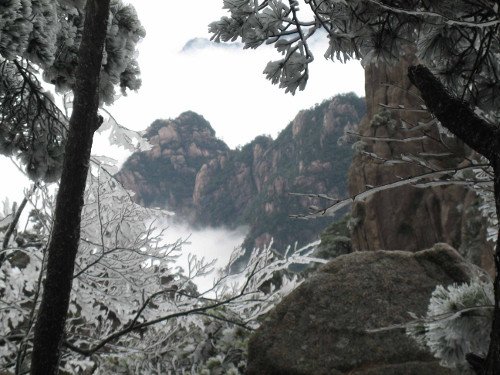(Above Photo: Memorial archway dedicated by Wanli Emperor (Ming dynasty) to Hu Wenguang, Huizhou’s governor.)
China…you think of the Great Wall, the Terracotta Warriors in Xi’an, the Pearl Tower in Shanghai. But have you ever heard of Xidi, a small village in Anhui province close to the Yellow Mountains, less than an hour from Shanghai by plane (or over 10 hours by train, your call!)?
My name is Gwen and I love backpacking. When I have some free time, I travel around China and stay in guesthouses. My favorite time of the year to go to the Yellow Mountains is winter because it is magical up there when it is cold. I wake up at dawn and wait for the sunrise to warm me up. The pine needles and the tree leaves are covered with ice, and still one can see the yellow buds underneath. Squirrels and native macaques seem to wonder what happened to all the tourists and megaphones.

A visit to Huangshan would not be complete without spending some time in a small rural village like Xidi. I would lie if I told you Xidi is a remote village without electricity and running water. It has become a popular destination since it was listed on the UNESCO World Heritage List in 2000. It all started with the Hu Family, a very influential family in commerce and politics, whose members became imperial officials during the Ming and the Qing dynasties. They later settled in Xidi where they became merchants and started building residential houses, schools, halls and temples dedicated to the ancestors. At its peak in the 19th century, the village had more than 600 residences. It started to decline during the later Qing dynasty and the disintegration of the feudal clan system. Today it comprises about 120 well preserved residences.
I like going there in the winter and spending a night there. I wake up at an early hour and walk through the deserted narrow alleys. I am back in time and witness the village awake to life. A young lady washes her face in a waterway dating from the 14th century; she raises her head at the sound of a bell. An old woman pushing a wooden cart is selling fresh tofu; within minutes, villagers clean out her supply. I can’t help taking a glimpse through a half-open door: behind these imposing whitewashed outer walls with tiny little windows – to prevent robbery – are hidden some courtyards decorated with delicate carvings and bonsais. The shop owners are slowly taking out the wooden panels that act as main doors and look forward to the morning tourist buses. It is time to go and on my way back to Shanghai, I can’t help thinking about all the other ancient villages around China that don’t have the UNESCO support and vanish under the merciless urban development…
Gwen Besrechel is an Imperial Tours Itinerary Designer. Originally from the beautiful, windswept region of northwestern France she has spent the last 9 years in cosmopolitan Shanghai. A natural linguist, Gwen opted to explore China, foresaking her original career teaching German in secondary school. As comfortable in English and German and of course her native French as she is in Chinese, when she is not designing amazing itineraries, Gwen is hiking a trail through stunning landscapes all over the world. As well as crossing many mountain ranges in China – from Guilin’s karst spires to Huangshan’s granite tusks – Gwen has trekked five continents from the Inca Trail in Peru to Gunung Rinjani in Indonesia.